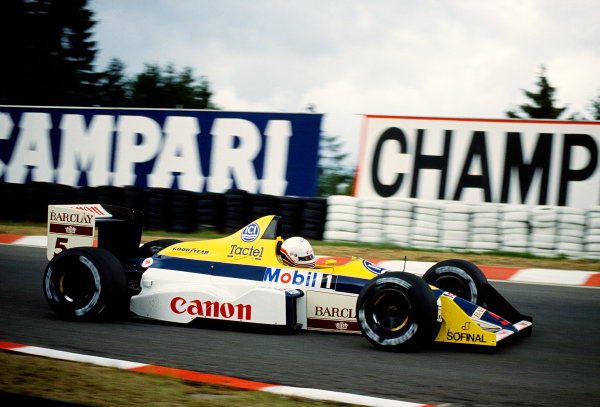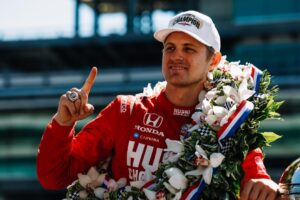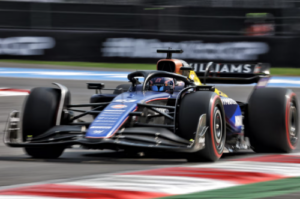The second part of examining F1’s biggest hypothetical scenarios sees us focus on all the oh-so-nearly driver signings by the Williams team.
After many years of toil in the back and the middle of the grid, Sir Frank Williams’ eponymous Formula 1 team finally made their much-deserved breakthrough in 1979. A first win at Silverstone in 1979 was followed by their first title just one year later. Much of the ’80s and ’90s would see Williams enjoy enormous success and were often the class, and the envy, of the pack. Many great drivers would flock to the team, and many would eventually leave the team. Many drivers also came close to a drive with the team, with circumstances preventing them.
1 – Gilles Villeneuve, 1983
In the aftermath of Villeneuve’s death at Zolder, commentator Murray Walker spoke of the rumors of a possible switch from Ferrari. Villeneuve’s relationship with team-mate Didier Pironi soured after the Frenchman’s victory over Villeneuve at Imola, in which Pironi was said to have disobeyed team orders to win. If Villeneuve had not been killed in qualifying for the following Grand Prix, how might joining Williams have shaped his career?
Williams was one of the top teams in F1, and despite a tough 1983 and ’84, regained form in ’85 with three wins. In 1987 Nelson Piquet added a third Drivers’ title for them after both he and Nigel Mansell narrowly lost out to Alain Prost in ’86. Villeneuve’s brilliance with a Honda-powered Williams car behind him may well have helped him finally claim a much-desired Championship had he been behind the wheel.
Williams and the Villeneuve name would eventually come together, however, with Gilles’ son Jacques joining the team in 1996, becoming World Champion one year later, the most recent man to do so for the team.
2 – Jean Alesi, 1991
Like Villeneuve, Jean Alesi’s folklore status is for racing a numbered-27 Ferrari, but things were so nearly different for the exciting, diminutive French-Sicilian. After bursting onto the Grand Prix scene in 1989 with Tyrrell (the same year he also became Formula-3000 Champion), Alesi signed full-time with the team for 1990. He caught the attention of the world by leading the opening round in Phoenix, finishing 2nd after a memorable duel with Ayrton Senna. Another 2nd would follow in Monaco, and Alesi was now hot property. Williams acted quickly and signed an agreement with him for ’91. But a spanner was thrown into the works when Nigel Mansell, then at Ferrari, announced his retirement, opening up a vacancy with the Scuderia, who seduced Alesi into changing his mind. Mansell was enticed out of the decision by Williams, and would eventually win the title in 1992.
At the time of the signing, Ferrari was the better bet, as Alain Prost was in the midst of a title challenge, with Williams rebuilding after a lax spell. But if Alesi had stuck with Williams, the chances are, given the level of dominance the Williams team built with the production of their FW14B car, and the subsequent FW15C, Alesi may well have become a one or even two-time champion. Ferrari’s fortunes reversed just as fast as Williams’, and Alesi was resigned to only one win in a career that spanned 12 years.
3 – Martin Brundle and Mika Hakkinen, 1993
With Mansell deciding to leave the team after the signing of Alain Prost for 1993, and with team-mate, Ricardo Patrese already signing for Benetton, the second seat – the most coveted in Formula 1 – was up for grabs. The team ultimately chose its loyal test driver Damon Hill to partner with Prost, but both Mika Hakkinen and Martin Brundle were said to be close to the drive.
Hakkinen, who had been left without a drive for 93 after two years with Lotus, was a future star, and Brundle had already spent several years in F1, spending one of them as a Williams tester, deputizing for the sick Mansell in Belgium in 1988. Also a Le Man’s winner, Brundle enjoyed his best season in ’92 with Benetton, his stock was never higher. If one of the two had been chosen to become Prost’s team-mate and stuck with the team as long as Hill, Hakkinen may well have won the World Championship far earlier than he did, and Brundle may have finally taken what, in reality, became a seldom Grand Prix win, as well as the possibility of title glory.
4 – Nigel Mansell alongside Alain Prost or Ayrton Senna, 1993
Ever keeping his ear to the ground, the legendary Ayrton Senna became interested in a Williams seat after the team’s resurgence in his third title-winning year in 1991. Realising McLaren’s most dominant days were over, Senna allegedly offered to drive for Williams for free, but with Prost already signing, and imposing a clause to bar Senna from joining with him, he would miss out. Mansell, apparently angry with the Prost deal and other alleged un-kept promises with his contract, joined Newman-Haas’ Indy team in 1993.
Would Mansell have beaten Prost or Senna had he continued? The answer is quite possibly yes. Despite Prost and Senna’s myriad of talents, Mansell was au fait with the active suspension of Williams, which required an abundance of Mansell-esque bravery to tackle. During the 1993 season, Prost was often unsure of the car, stalling it on several occasions before or during races. However, with team orders in his favor, plus the car’s significant advantage over all others, he would still win a fourth title. Senna, meanwhile, had battled long and hard with Mansell on several occasions, and such battles in the same team would have been a mouthwatering prospect for fans.
Both men did not take kindly to Prost’s joining of Williams, Senna outspokenly criticizing his long-term rival in the press conference after the 1992 Portuguese Grand Prix.
Gilles Villeneuve took a remarkable victory on the streets of Monaco On This Day forty years ago, beating the superior Williams cars; here he is in his traditionally spectacular style leading Alan Jones. 🔀😳https://t.co/kk2BNimnKb pic.twitter.com/FjeQgpF5VW
— Motorsport Images (@MSI_Images) May 31, 2021
5 – Nigel Mansell retained by Williams, 1995
After Senna’s tragic death after finally joining Williams in 1994, the team alternated between Mansell – and David Coulthard for the remaining races. Mansell won the final round in Australia, setting him up nicely for a full-time seat for 1995. However, Williams opted for Coulthard, with Mansell joining McLaren in retaliation.
Had Mansell stayed at Williams, could he have made the title a three-way battle between himself, team-mate Hill and reigning World Champion Michael Schumacher? The Williams was faster than the Bennnaton but reliability and strategic issues allowed Schumacher to claim his second title.
6 – Damon Hill retained by Williams, 1997
Williams decided to replace Hill for Heinz-Harald Frentzen in 1997 before Hill won his overdue title in 1996. Frentzen would finish 3rd in the standings (elevated to 2nd after Schumacher’s season disqualification), and after only two years and would join Jordan in 1999, partnering Hill. Despite an uncompetitive and unreliable Arrows-Yamaha, Hill showed Williams what they were missing with an impressive 6th at Silverstone, an incredible 2nd in Hungary, and a 4th-place start in Jerez.
Could Hill have continued his inter-team rivalry with Jacques Villeneuve, and taken the fight to old foe Schumacher in 1997? Hill would have likely been aware of the ’97 car, and his prowess with testing would have given him enough to become at-one with it by the time of the first round in Australia. With ‘1’ on the car, the fastest car still of all, Hill may well have claimed back-to-back titles.
Formula 1’s Biggest What-Ifs continues with Part 3, in which we focus on two of Britain’s most underachieving talents, as well as an American.






